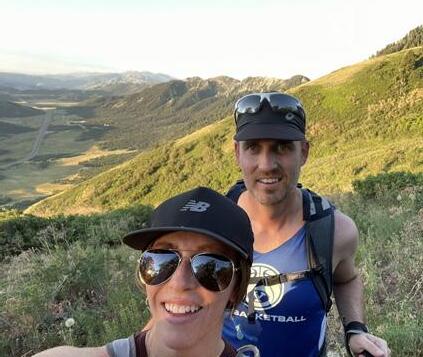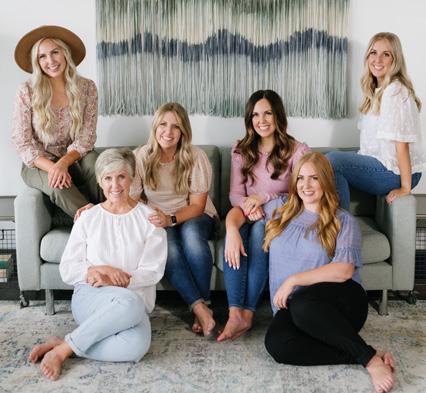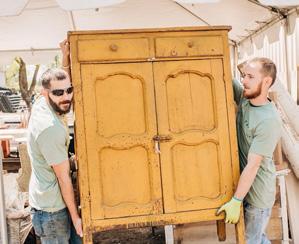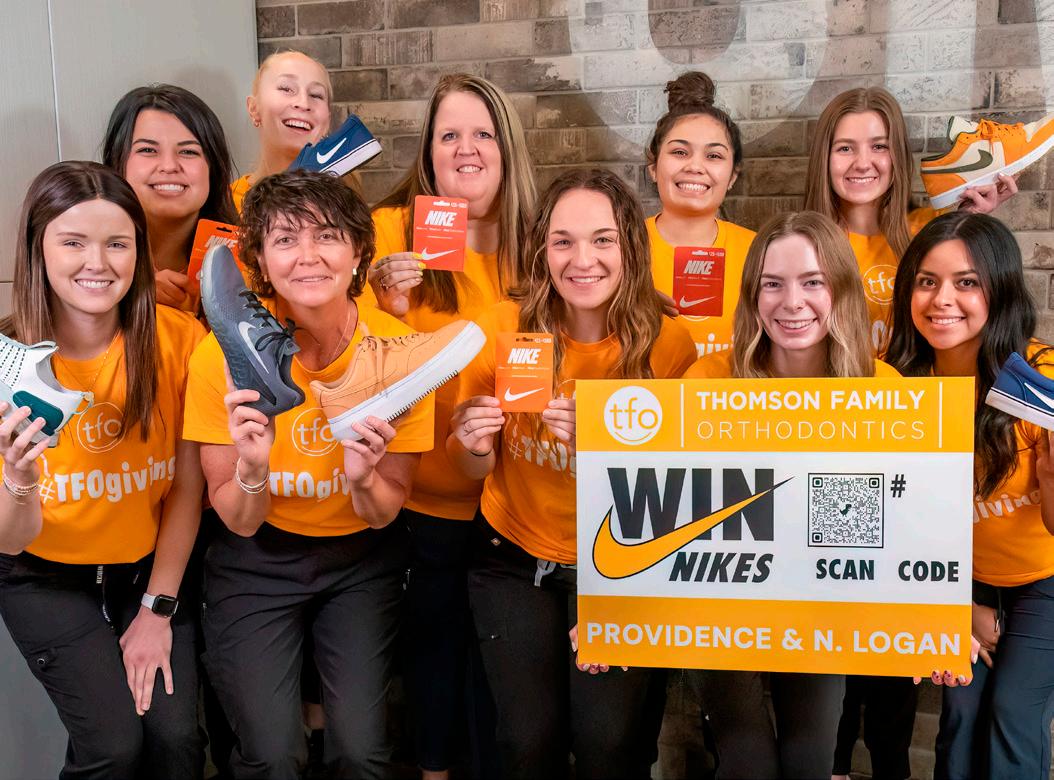
SPRING 2023 INSIDE THIS ISSUE: Connect With Your Teenager • Tips to Help You Navigate Vintage Market Days • Protect Your Kids from Online Predators • Best of Cache Valley: Obscure Edition SIX SISTERS STUFF: Women Who Connect Over Food and Motherhood



Ask about our entrance exam waiver. Currently accepting applications. Apply now! 3 DELIVERY OPTIONS: WITH Face-to-face Live Broadcast Interactive Online Vard Wells 2021 Utah State MBA Graduate UtahStateMBA.com It’s Worth It!






LETTER FROM THE EDITOR
The desire to come together and connect with friends, family, groups, and community is culturally celebrated around the world.
Memorable atmospheres are created when behavior and emotions align within a gathering. Groups that share a common focus with expressions of contagious excitement create value for everyone involved.
Last April, my husband and I had the opportunity to visit Yankee Stadium in New York for the first time. I’m not even that big of a baseball fan, but it was a powerful experience that began before we even arrived at the ballpark.

Obviously tourists, we weren’t exactly sure how to make it from Manhattan to the Bronx. As we approached the subway station and had to decide which train to take, we looked at each other and laughed — there really was no question: We confidently followed the sea of people geared up in Yankees merch. The subway was PACKED, shoulder to shoulder, standing room only. But despite any stereotypes you may have for New Yorkers, the train was filled with shared joy for the 26-minute ride. The experience of being together had already begun.
In a region where people aren’t known for
striking up friendships at random, we were chatting it up and exchanging cheers with people on the train, in line for a hot dog, as we celebrated a home run, and as we sang during the seventh-inning stretch.
Ballparks aren’t unique to this shared joy of gathering. Theaters, churches, coffee shops, and even backyard BBQs all provide the atmosphere for it.
As poet John Donne said, “no man is an island.” People need other people. Our personal wellbeing, both physical and emotional, is tied up in it. Not only is gathering enjoyable, but it also nurtures important relationships and promotes a sense of belonging and community.
After what felt like a longer-than-usual winter, which can sometimes feel secluded and lonely with more time spent indoors, I am looking forward to a renewed season of gathering. We’ll call family together for Easter celebrations, enjoy small-town festivals and concerts in the park, and even casual visits with neighbors in the yard. These simple interactions leave me feeling inspired, rejuvenated, and connected, even when it takes a lot of work to make them happen.
Here’s to wishing you a happy spring and a season of gathering.
Publisher & Editor in Chief
EMILY BUCKLEY
Copy Editor
TARA BONE
Cover Photography
MEGAN OSBURN
Layout Design
THE UNBURDEN STUDIO
Website Design
KITE MEDIA
Contributing Writers
CLAIRE ANDERSON
MARK ANDERSON
KIMBERLY BLAKER
K. BONE
TARA BONE
EMILY BUCKLEY
BAILEIGH CAMPBELL
MICHAEL COLE, OD
JENTRIE HALES
SARAH LYONS
CHERYL MAGUIRE
KATE NEELEY
NORTHERN UTAH VINTAGE
MARKET DAYS
FRANK SCHOFIELD
LETICIA SHIFFLET
Cache Valley Family Magazine is a free, trusted resource designed to inform, serve, and enrich local parents and families throughout Cache Valley. Material in this publication is copyright 2023, Cache Valley Family Magazine. All rights reserved. Reproduction without permission of the publisher is prohibited. The views expressed in the magazine are the views of the writers and do not necessarily reflect those of the publisher.

Please send all editorial correspondence to info@cachevalleyfamilymagazine.com or by mail to PO Box 6831, North Logan, UT 84341. All correspondence is sent on a non-confidential basis and Cache Valley Family Magazine shall be free to reproduce, publish, edit and/or use any such communications. All materials become property of Cache Valley Family Magazine.
PHONE NUMBER
(435) 764-0962
MAILING ADDRESS PO Box 6831 North Logan, UT 84341
EMAIL
info@cachevalleyfamilymagazine.com
WEBSITE cachevalleyfamilymagazine.com
FACEBOOK
/cachevalleyfamilymagazine
YOUTUBE
/cachevalleyfamilymag
INSTAGRAM @cachevalleyfamilymag
TO ADVERTISE call (435) 764-0962 or email ads@cachevalleyfamilymagazine.com
4 | Spring 2023
FOR THIS ISSUE
SPONSOR
HEALTHY FAMILIES
Powerhouse Veggies to Incorporate Into Your Family's Diet ... pg 12
FACT CHECK
Cache Valley's Obscure Bests ... pg 19

COVER STORY
Six Sisters Stuff: Women Who Connect Over Food and Motherhood pg 24

EDUCATION UPDATE
Cache County School District: To Test or Not to Test — Why Standardized Testing Actually Matters ... pg 28 Logan City School District: Showing Up is a Secret to Success in School and Beyond ... pg 29
FAMILY MATTERS
Organize and Protect Your Digital Memories: It's Possible! ... pg 32
MAKING A DIFFERENCE
The Policy Project Advocates ... pg 38
BEST-IN-CLASS YOUTH SPOTLIGHT
Tenzing Roper: Climbing Higher in Utah's Mountains ... pg 40
GOOD NEIGHBORS
Real Estate as an Attractive Inflation Hedge ... pg 43
Connect With Your Teen — Even When They're Never at Home ... pg 6
Gardening: All Fun, and No Work ... pg 10
Protecting Kids from Online Predators ... pg 16
Six Reasons to Make Family Dinner a Priority ... pg 26
Glasses Lenses are Not One Size Fits All: Understanding Your Options ... pg 31
Navigating Vintage Market Days: Five Tips to Get the Best Out of Each Market ... pg 35
Classes + Camps Guide 2023 ... pg 44

| 5 IN EVERY ISSUE FEATURED ARTICLES PAGE 21
PAGE 24 PAGE 35
Connect With Your Teen — Even When They’re Never at Home
CHERYL MAGUIRE contributing writer
I feel like I never see my 17-year-old twin teens anymore. School, sports, activities, work, and friends all call them away from home. I try to convince myself that their packed schedules help ease me into the transition of them going to college next year, but the truth remains — I miss spending time with them.
According to Maria Sanders, LSW, a clinical social worker and certified parent coach, my situation is ordinary. “Doing your own thing is normal and healthy in those teen years, but it is tough for us parents,” she said.
She’s right. It is difficult. For me, and many other parents. On the one hand, as teens shift toward adulthood and become more independent, we’re excited for them. Ken Ginsburg, MD, the founding director of The Center for Parent and Teen Communication in Philadelphia and author of Congrats — You're Having a Teen!: Strengthen Your Family and Raise a Good Person, says that “the major difference
between the teen years and the tween years is the extra experiences that young people have. They've learned to stretch their wings and to succeed.” But he also says, “In addition to that, they have the ability to think differently.” In other words, as our children mature into adulthood, they form their own thoughts and opinions, which may not align with our ideas and make it more difficult for us to connect with our teens.
We want a deeper connection with our teens, but…
OUR TEENS DON’T HAVE MUCH TIME FOR US. Maria says that once our children move into their teen years, they have most likely figured out who they are. They’re capable of better conversations and potentially forming deeper connections with family members. It can strain the entire family when teens don’t have time to invest in those core relationships because of other commitments. When our teens aren’t
at home much anymore, it’s like a practice mourning period. “We're missing our teens — they're out of the house, and there is a period of loss,” Maria said. “There is a period of, ‘I see where this is going. They are going to leave soon.’”

WE WORRY (A LOT) THAT OUR TEENAGERS ARE TAKING UNNECESSARY RISKS.
Now that our kids have grown more independent, they’re also taking more risks than they did as tweens. In 2022, the Center for Disease Control (CDC) released their injury and fatality statistics for 2020, stating, “About 2,800 teens in the United States ages 13 to 19 were killed, and about 227,000 were injured in motor vehicle crashes in 2020. That means that about eight teens died daily from motor vehicle crashes, and hundreds more were injured.” Data like that support the worry we feel when our teens drive cars, or when they’re a passenger in the car of a new driver. Of course, we will worry about their safety on the road.
6 | Spring 2023
We have a lot to worry about with their growing independence. For example, now that our kids are teenagers, we also worry about their access to drugs and alcohol and having sex, too. If our teenagers are sexually active, we worry about sexually transmitted diseases and pregnancy. We may also worry about their friendships and romantic relationships and whether they’ll be hurt emotionally or manipulated. We worry about many things because, as Maria says, “There are a lot more opportunities for teens to get together without adult supervision, so [these things] come into play.”
OUR TEENS PICK A LOT OF FIGHTS WITH US.
Teenagers are pros at testing limits and pushing boundaries, sometimes leading to arguments when parents try to dictate what their teenagers can and cannot do. “When parents try to control their kids, it comes from a place of fear: ‘I'm afraid I'm going to lose my child.’ We want to clasp on as hard as we can to feel like we're in control. But we can't control our kids,” Maria said.
Experts tell us we can still form deeper connections with our teens despite those challenges.
How to form deeper connections with our teens:
Adolescents are moving toward becoming independent of their parents physically, emotionally, and cognitively, yet they still need parent and family support as much as they did when they were younger. Here are some ways experts suggest we support teens.

BREATHE.
It can be tough to stay centered and calm when our teens are determined to criticize us at every turn. Our first instinct might be to respond with anger, but Maria says this will only cause more problems. “There's a phrase called ‘no action in reaction.’ If we are reacting to something our kids did, let's say your child comes home late. Then that's not the time to act because you are in a reactive mode. Don't take any action. Instead, take a deep breath, a big pause, maybe sleep on it, and discuss it when there is a good time, and you're calmer,” she said.
BE CURIOUS.
Suppose your teenager is having trouble with following limits, like not coming home in time for curfew or letting the car run out of gas. In that case, Maria recommends using Dr. Ross Green’s method of collaborative problem solving, where parents and kids work together to solve problems within their relationship.
Maria offers an example of how this might work continued on next page…

| 7
…continued from previous page when your teen is struggling with coming home on time for a curfew:

Parent: “It seems like you've had a difficult time getting home at curfew. Help me understand what's going on.”
Teenager: “Nobody starts to hang out until 9 o'clock. So if I have to be home at 10 o'clock, I only get an hour with my friends.”
Parent: “OK, that's good information. What's important to me is that you do get home because I'm concerned about your safety. After 10 p.m., things start to get sketchy. So I’m wondering what ideas you have so you can hang out with your friends and still make it home on time.”
This kind of practice allows teens and parents to come together to define consequences. “It's not just the parent, dictating what the consequences are,” Maria said. “It's the parent and the child, having their concerns put on the table and figuring out a solution that works for everybody.”
Dr. Ginsburg agrees. “Your ultimate goal with your teenager is to have a relationship that lasts for decades after they've left your house,” he said. “If they are struggling to become independent and you become very controlling, they will push you away.”
He also stresses the importance of communicating that we respect them. “When we tell kids what to do based on our experience, kids are hearing the message, ‘I don't think you're capable of figuring this out on your own,’” he said.
Dr. Ginsburg suggests instead that we be curious and ask questions about how they can solve problems on their own. “When we ask them what they're experiencing, and ask them what they think is going to happen, then we give them the opportunity to think things through.”
CREATE RITUALS AND ROUTINES. Rituals and routines are a great way to connect with a teenager who is often not able to spend as much time with their parents and siblings. For example, even though my
teenagers didn’t need me to walk them to the bus stop in the morning, I created a routine so that I could have extra time to connect with them.
“It’s important to find those family traditions that can be carried through to when they are older so we're able to have that connection,” Maria said. She says one example is her family’s annual summer camping trip, where they go screen-free because quality time together without their screens is good for developing adolescent brains and for family dynamics.
KNOW THAT YOU STILL MATTER TO YOUR TEEN. The teen years are full of incremental moves to separate from parents. For both parties, it’s an exciting time for personal growth; yet, those moves toward separation can also be scary and stressful.
“There are a lot of myths out there about adolescence,” Dr. Ginsburg said. “One suggests that adolescents don't care what adults think and don't particularly like their parents. Know that definitively and without question: You matter to your teen.”
8 | Spring 2023

Gardening: All Fun, and No Work
MARK ANDERSON owner, Anderson’s Seed and Garden

For as long as I can remember, my parents had a big garden. Big is a relative term, but I mean big — like quarter-acre big. Growing up, I worked in the garden with my parents, and for me, it was always a lot of fun. When I’d call my friends to get together and play on Saturday, they’d almost always tell me the same thing, “Maybe later, I have to go work in the garden.” I always thought it was strange that they would say that because our garden was 10 times bigger than theirs, but by Saturday ours was already weeded, watered, and fertilized, and they still had “work” to do.
Gardening shouldn’t be work, it should be fun, relaxing, enjoyable, stress-relieving, and, most importantly, delicious.
Teach yourself, and your children, how to have fun in the garden, so it becomes a joy and not only a labor.
Follow these easy suggestions to keep your kids invested and engaged in gardening together as a family. Otherwise, it will become work they don’t want to do, and you’ll miss out on a great opportunity to spend valuable, high-quality time connecting with your children having “fun” together in the garden.
START SMALL.
Too large of a garden will very quickly become overwhelming and too much to handle. A small garden can always be increased next year.
10 | Spring 2023
LET THE KIDS GROW THEIR OWN PLANTS. Do something easy to start, like a zucchini plant or pumpkins if you have the space. They produce like crazy, and your kids will feel successful quickly.
GARDEN IN SHORT BURSTS.
20-30 minutes here, 40 minutes there; always in the early morning or evening when the temperatures feel more pleasant. If you try to do it all on Saturday morning, you’ll be
“working” every weekend. A little every day turns into “no work” on Saturday.
DON’T HESITATE TO EXPERIMENT.
New, exotic, and different plants catch children’s attention. Try multi-colored chard, yellow watermelon, UFO spaceship-shaped squash, or rainbow carrots. Hundreds of fun, exciting varieties wait for you to try them.

DON’T BE AFRAID TO FAIL.
You’re almost destined to have a failure or two each year, but understand that gardening is a learning process, and if you don’t fail, you won’t get better at it. Also, your children will learn that it’s OK to fail, everyone does at some point, and that there’s always next year to try again to succeed.

Follow this simple advice, make up some fun gardening activities of your own, and customize your plans for the different needs of your children and you’ll be having fun in the garden in no time.
Make gardening fun, for you and your kids, and leave the “work” to someone else.
| 11
Powerhouse Veggies to Incorporate into Your Family's Diet
KIMBERLY BLAKER contributing writer

We know veggies are vital to our (and our kids') health, whether we like them or not. But do you know that not all vegetables are created equal? Each one has a unique combination of nutrients and benefits — some, in particular, though, are powerhouse sources of nutrition.
If you or your kids aren't vegetable fans, that's all the more reason to try a wider
variety. There are bound to be a couple of veggies your family will dig if they're prepared just right. If those vegetables you learn to love happen to be some of these allstars, all the better.
BUTTERNUT SQUASH
This winter squash is loaded with vitamin A, in fact, four times the recommended daily allowance (RDA). It also contains double the
RDA of vitamin C and packs more potassium than a banana.
How to eat it: To turn your family into butternut squash fans, first, cut it in half, and remove all the seeds. Then fill a glass baking dish about 3/4" high with water, place the pieces of squash with the skin facing up, and bake at 400 degrees for one hour. Allow the squash to cool enough to handle it, then scoop it out of the peel and
12 | Spring 2023 HEALTHY FAMILIES
top it with butter. If that doesn't suffice, try adding a touch of brown sugar.
KALE
This dark green leaf packs 684% of the RDA of vitamin K and well over the RDA of vitamins A and B6.
How to eat it: Add a kale mix to the lettuce if your family likes salad. If you're not salad eaters, kale makes a great addition to smoothies.
SWEET POTATOES
Vitamins A, B5, B6, riboflavin, thiamin, niacin, and carotenoids are their nutritional makeup.
How to eat it: The good news is, Thanksgiving isn't the only time to eat sweet potatoes. They make yummy french fries, which can even be baked rather than fried. Look for one of the many baked sweet potato fry recipes available online.
PEAS
These contain a long list of nutrients. Of particular note, peas are very high in vitamins B1, C, and K, manganese, copper, phosphorus, and folate.
How to eat it: Fortunately, peas are one vegetable most kids and adults will eat. Add peas to a variety of soups, stews, and casseroles. Another tasty option is to add them to macaroni and cheese.
BELL PEPPERS
Red, orange, yellow, and green bell peppers are all nutritious, whatever the color. All are high in vitamin C, with red bell peppers containing 169% of the RDA. Also, bell peppers are high in vitamin A and carry many other nutrients.
How to eat it: Do your kids live by the motto, “everything tastes better with ranch?” If so, try bell pepper slices for dipping. Bell peppers are also great on pizza and sautéed to go atop hot sandwiches.

BRUSSELS SPROUTS
This veggie is noted for vitamins K and C, but brussels sprouts also provide numerous other nutrients in decent amounts.
How to eat it: Cut them in half, then stir-fry them in sesame oil with other vegetables. Another trick is to roast them with olive oil and salt.
ASPARAGUS
Folic acid is what asparagus is especially noted for because it contains 60% of the RDA. But asparagus also includes a healthy amount of vitamins K and C, as well as several other essential nutrients.
How to eat it: Grilled asparagus is a tasty side. Before grilling, brush the asparagus lightly with olive oil, then add salt and pepper. Place the spears on the grill for 10 minutes, turn them, then give them a few more minutes until they're lightly blackened.
continued on next page…
| 13
…continued from previous page



SPINACH
Now here's an impressive number: Spinach contains 987% of the RDA of vitamin K. Spinach is also an excellent source of vitamin A, manganese, folate, magnesium, iron, copper, and several other nutrients.


How to eat it: You can add spinach to smoothies and pizza. Spinach quiche and spinach pie are also dishes many kids love.

BROCCOLI
Here's another vegetable that's a rich source of vitamin K, packing 245% of the RDA. Broccoli also exceeds the RDA for vitamin C and is an excellent source of chromium, folate, and fiber.
How to eat it: Mix broccoli into almost any cheesy dish. Broccoli cheese soup, broccoli smothered in cheese, and other cheesy pasta dishes with broccoli added are good options.
AVOCADO
Although not a powerhouse of any particular vitamin or mineral, avocado still carries an adequate amount. Particularly notable
is that avocado is an excellent source of polyunsaturated and monounsaturated fat, which are healthy fats.
How to eat it: Guacamole is an all-time favorite. Avocado is also yummy mixed with egg salad or a tossed salad.
PUMPKIN (CANNED)
Pumpkin is an outstanding source of vitamin A, containing 2 ½ times the RDA, not to mention a fair amount of a host of other vitamins and minerals.
How to eat it: Numerous desserts can be made
from pumpkin. So the next time you're in the mood to bake, make something with some added nutritional value. Try making pumpkin pie, bread, cookies, or cheesecake.
SCALLIONS
Also known as spring onions, scallions pack 172% of the RDA of vitamin K. They're also known for their antioxidants and are a good source of vitamin A.
How to eat it: Scallions can be grilled just like asparagus. Brush them with oil, add salt and pepper, then toss them on the grill until lightly browned. For a special treat, wrap them in bacon.
14 | Spring 2023 WWW.CACHEGRANDFONDO.COM JULY 08, 2023 LOGAN, UTAH 35M 53M 76M 104M ‘23 Event of the Year $20 OFF WITH CODE CacheFamily2023

Protecting Kids from Online Predators
JENTRIE HALES community advocate, @techhealthyfamily
My 4-year-old and I recently watched the children’s movie Zootopia together. There, we learned all about predators. We learned that they come in all shapes and sizes. Animal predators can be as obviously dangerous as a lion or a polar bear or as subtle as a little sea otter or a skunk. We learned that predators prey on smaller and weaker animals around them when they are in their natural state. The movie also teaches us that before animals evolved to live peacefully together, predators were dangerous and could not be trusted.
As informational and frankly beautiful as the movie was, it got me thinking about the parallels of online predators. Unfortunately, this is becoming a more common topic of discussion as we regularly hear example after example about children’s harmful and dangerous experiences with online predators who are going “savage” online.
According to the Child Crime Prevention and Safety Center, there are an estimated 500,000 active predators online and active each day, many of whom have multiple accounts and outlets they are using. Sadly, children ages 12-15 are most targeted by predators. The majority of these conversations happen through chatrooms and instant messaging. That fact is alarming to consider because almost every app we use, whether games or social media, has a way to chat internally with other users.
These conversations first happen innocently by the predator feigning “friendship.” But as they groom our children, phish for identifying information, and then mirror their feelings and emotions, they build strong, dangerous bonds that allow them to manipulate and isolate children into doing whatever they want. A lot of the time what they are after is sexual
conversations and images, and sometimes inperson meetings.
Who are these people that have unlimited time to build connections and trust with young, impressionable people? While some statistics are available, the short answer is, WE DO NOT KNOW. That is what makes it scary and alarming. The online world makes it so easy for these people to be elusive and secretive.
Combining my professional experience with others, here are some ‘don’ts’ when approaching the topic of online predators.
Don’t assume your child is immune to the influence of an online predator. These people are professionals. They have unlimited children to try their techniques on, as well as apps that make it easy for them. Recently TikTok came out with the “teen” filter (which surprisingly

16 | Spring 2023
doesn’t change your appearance to add acne and braces) that changes the user's face to look like a much younger version of themself. We innately have instincts that help keep us safe, but features like this make it harder and harder to be in tune with that instinct.
Don’t send your kids to places where predators are. It’s harsh and not the answer our children are looking for, but people that prey on kids
go where the kids are. According to Bark, a parental controls app, some of the most common places predators are found include Snapchat, Discord, Instagram, Among Us, and Roblox. If you or your child is using technology for any form of conversation, online predators should constantly be a discussion.
Don’t let someone else have a closer relationship with your kid than you do. Be aware of what’s
going on in your child’s life. Know what they do online. Know what they like and don’t like. Know what they are worried and stressed about. Validate their emotions and feelings. Be present and engaged with them. Be someone they can go to so they don’t feel encouraged to go to someone else.

Parenting in the digital world can be overwhelming and scary, but not ignoring these issues is much more terrifying.

Jentrie Hales is a community advocate with five years’ experience empowering parents and children in different settings. She has been invited into classrooms, youth groups, and parent groups throughout Cache Valley to speak about healthy relationships with tech and professionally mentors families that feel overwhelmed with managing the tech in their home. Connect with her at techheatlhyfam@ gmail.com or on Instagram @techhealthyfam.
Sources:
childsafety.losangelescriminallawyer.pro/childrenand-grooming-online-predators.html
edu.gcfglobal.org/en/internetsafetyforkids/stayingsafe-from-online-predators/1/#
| 17 WHEN YOU BELEIVE BEGINS 435-753-2500 capsa.org APRIL IS SEXUAL ASSUALT AWARNESS MONTH FEELING HOPELESS is normal as a parent of a child who was sexually assaulted. When you START BY BELIEVING, you are taking the first step to HOPE and HEALING CAPSA CAN HELP!




CVCBALLET.ORG For class schedules, registration, and more, visit cvballet.org. Logan, Utah 84321 • (435)753-3633 Whittier Community Center The Cache Valley Civic Ballet-School offers qualified training in classical ballet to members of the community of all ages and skill levels. The school combines a dedication to ballet and a love of children to provide excellent training and a positive experience. Celebrate 40 Years of Ballet in Northern Utah
obscure edition
Cache Valley’s Obscure Bests
 KATE NEELEY contributing writer
KATE NEELEY contributing writer
Popular opinion is definitely a thing, and you know it’s super cool to give and receive recognition for local BESTS in Cache Valley. You know, the best business, best photographer, best artwork, best restaurant … but what if, just for fun, you think a minute about your very own Cache Valley Bests — lesser known things like your best route getting to work or home from the grocery store, your favorite place to walk your dog, or that one stall in a public bathroom that’s always clean and quiet. You know you have them.
Here’s the thing, though. A lot of you have been reluctant to share your personal bests. More than one of you expressed the fear that if you tell about your favorite spots in this obscure article, somehow they will become overrun with people who want your experience. I can respect that, but I also think that says something about Cache Valley. It’s literally a treasure trove of beautiful, peaceful, quirky, and interesting gems. There must be plenty to go around if you want to keep yours a secret.
Some Cache Valley Bests, like the Wellsville Range, are simply too big to be kept a secret. There is nothing quite like that skyline. If you have lived in Cache Valley for a substantial amount of time, you are now required to ask yourself if you’ve hiked the Wellsville Ridge. Not an easy feat, but one that is sure to take you from casual Cache Valley fan to true believer.
Once you have traversed the trail that starts at the Rattlesnake Trailhead with natural green ferns as tall as you and leads to wildflowers in the breeze and some of the coolest fossils up top, it’s like a trip to Hawaii, Switzerland, and a natural history museum all in one day. It’s bound to be an Indiana Jones-esque adventure as well — there are rattlesnakes sunning on
the trail at certain times of the summer. Once you’ve done it, you will never look at the Wellsville Ridge the same, guaranteed.

Speaking of looking at that ridge, a sunset over the Wellsville Ridgeline is one of the best sights to behold. If you’re as lucky as Nikki of Providence, your back deck might be the best place to see a spectacular sunset. But if your deck isn’t thus placed, a lifelong Cache Valley resident, Jade, says you can catch an incredible view via the Utah State University parking lots connected to the south side of 400 North. In and around the Cliffside neighborhood in Logan, the top of Mount Logan, the bench neighborhoods in Hyde Park, or the deer fence trail above Millville are some other great options to catch the golden hour and spectacular beauty of a Cache Valley sunset.
If you’re jonesin’ for a great picnic spot in warmer months, some of Cache Valley’s favorite spots are the gorgeous and shady Merlin Olsen Park or Riverside Park on the Island in Logan. Krystal of Hyrum shared a great idea about Blacksmith Fork that might be lesser known. “When you park to go on the riverwalk, there’s a little cove you might want to try out,” she said. continued on next page…
| 19 FACT CHECK
Best of Cache
Valley
…continued from previous page


Take your picnic to the next level with the perfect pebble ice. Are you a pebble ice fanatic? Cache Valley (or maybe Utah in general) seems to have a thing for the little cold treasure. It just makes your drink taste better, or maybe you like eating it alone! Either way, you shared some best places to get it. Taco Time, Chugz, Ginny’s in Nibley … and apparently, there’s even a way to have your pebble ice delivered! Did you know this? If not, go check out Pebbles the Ice Factory. Google it or find them on Instagram @pebblestheicefactory. That’s cool!
This past winter was one of the snowiest in recent years, and if you’re trying to find some fun in the white fluff that seems to be sticking around for longer than you planned (or for future reference), sledding could be just the ticket. Ben of Hyde Park shares that Lion’s Park has one of the best sledding hills. You can also hit Cliffside Park or Gibbons Park in Logan for a further-south sledding hill.
What about iconic people who you may not know personally but who seem to have a way of making you smile when you’re out running errands or doing mundane everyday tasks? Ashley of Millville

is surely not the only one who has noticed the employee of South Logan Walmart who has a beautiful singing voice and serenades shopping guests with classical or blues on the daily.
Does this jog your memory? Who else can you think of? Probably better known as “Bicycle Brent,” Brent Carpenter is another highly recognizable resident. If you have been in Cache
Valley for at least a little while, you will know who he is, the guy on the bike, with a backpack heavy-laden with stuffed animal keychains and the most friendly smile and wave, coupled with the sound of a bike bell or horn. Brent deals with some disabilities — or perhaps you could call them superpowers — that make him stand out as one of the kindest, most loving, and most recognizable Cache Valley residents.

20 | Spring 2023 UTAH STATE COURTS Divorce Education for Children • Classes are offered online each month • For children & teens ages 6-17 • Free of cost • Taught by licensed mental health professionals Our mission is to educate Utah families experiencing parental separation by empowering children with the tools that will enhance their social and emotional well -being. To register or view more information, visit our website: www.utcourts.gov/divorceedforchildren Or contact the Divorce Education for Children Program Coordinator by phone: 801-578-3897
Now that your heart is warm, what about some quirky bests? Like best-misspelled signs or ads around town. Can you think of any? There is a little sign in the basement of Ellen Eccles Theatre to label the dressing rooms for ensemble members of various casts. It’s probably been there for 35 years or longer. And it’s spelled wrong. Forever labeled as “dresing rooms.” Never offended by the oversight, these dressing rooms have been filled to the brim
with glittering ballerinas, energetic kids singing and giggling while getting ready to perform in a musical production, or friends warming up, tapping, and boisterously yelling “break a leg” before literally thousands of performances.








Speaking of Ellen Eccles, it wins another best award. If you’ve ever been to a show there, you may have been tempted to take a photo in their lobby bathrooms. They are beautiful, clean, and
have some pretty great lighting for selfies in the full-length mirrors.
Maybe you know Cache Valley roads like the back of your hand. Do you have a favorite road? Hollow Road is a beautiful one. Main Street is pretty iconic. It can get pretty congested, but on a Sunday morning, it’s a clear shot, and so romantic.
Speaking of hitting the streets, have you ever been in a car accident? According to one anonymous resident, the corner of 100 West and 100 South is the best place to get in a wreck. One late night with a truck laden with some large items, a Volkswagon smashed into his truck, scraping up the side and solidifying, in his mind at least, that this intersection is cursed. And perhaps it is. Or maybe just poor visibility. Sometimes the best things are just the best at being the worst, huh?
So, if some of these haven’t rung true to you, take a minute and think about what your personal Cache Valley Bests might be. Hopefully, it will give you the chance to realize you live in a pretty stellar place on Planet Earth. Cheers, my Cache Valley friends. You people are certainly one of my personal bests.

| 21


20%off! BOGO ITEM!FREE 30% off! FREECHOCOLATE Must present this ticket to receive an egg. Expires April 30, 2023. Limit one per family.
Spring Cleaning WAREHOUSE SALE
While supplies last!
Extra 10% off sale items for loyalty members! 40% 40% 30%
Build-a-Basket Easter Event!



Friday, March 24 10 a.m. to 2 p.m.
Bring your own basket, or buy one at the Book Table. Spend $50 and get your basket FREE. We will provide all the stuffings, bows, tags, and wrapping for FREE for everyone! Come get your baskets done early!

@loganbooktable /loganbooktable
30%
Women Who Connect Over Food and Motherhood
 EMILY BUCKLEY editor in chief
EMILY BUCKLEY editor in chief
Cyd Adamson gave birth to six daughters in 12 years. These sisters were close and loved sharing all the big and small moments in life, so naturally, as they grew up and moved out, they still longed to stay connected and communicate regularly.
“Six Sisters Stuff all started as a way for us to communicate with each other,” Kristen Hills, the second oldest Adamson sister who now lives in Cache Valley, but was one of the first of the family to move out of state, said. “Back in 2010 [it cost extra] to talk to people that didn't subscribe to the same phone provider. I remember my bill often being $100 over because I kept talking to my sisters. We needed to find a solution. So, the three oldest sisters started the blog in January 2011.”
The blog, Six Sisters Stuff, began as a way for the sisters to share their favorite books and the activities they were doing with their young children (although the youngest sister was still in middle school at the time!). Soon it evolved to sharing recipes.

After a while, just for fun, they installed a widget on their blog that tracked where visitors to the page were located, and they noticed that people from other states were finding and reading their blog.
“It was a surreal moment when we realized people we didn't know were using our recipes,” Kristen said.
Once the sisters realized people were coming to their blog, they got their entrepreneur dad on board, and he helped them put ads on the blog website. Over the next decade, as new social media platforms, like Instagram, YouTube, TikTok, became popular, they jumped on and learned how to grow their following.

“We now have over 4 million followers across social platforms,” Kristen said.
There is a 12-year gap between Camille, the oldest sister, and Kendra, the youngest.
“Usually, with that big of a gap, relationships
24 | Spring 2023
photos courtesy of Six Sisters Stuff
As the Six Sisters Stuff following grew, so did the workload. In the beginning, everyone worked together, but as the business progressed, and the younger three sisters started working, they realized they could be more efficient by splitting up the work. Each sister now has a different job and manages a specific part of the business.
The Adamson sisters that currently make up Sister Sisters Stuff include:
Camille Beckstrand, who handles their Facebook operations and search engine optimization, ensuring their recipes are seen when people search Google for them.
Kristen Hills, manages their YouTube and Amazon accounts. She loves figuring out strategy and studying the numbers on the backend.
Stephanie Loaiza is the email marketing queen. She loves strategizing digital products.
Lauren Walker started the Six Sisters podcast Table Talk for Moms in 2022. Rather than talking about food on the podcast, they talk about ways women can find joy in the phase of life they are in.


Kendra Murdock handles social media strategy, including Reels and TikToks. She also oversees their brand’s physical products, including their new spice line!
The Six Sisters have deep Cache Valley roots. Their grandparents, Tom and Charlene Lewis, were raised in the Valley and started their life together here. Every sister either attended Utah State University or supported her husband as he attended. Kristen lives in North Logan and says she tries every day to convince her sisters and mom to move to the beautiful valley.
aren't as close because you live very different lives. But by working together, we have very close relationships,” Kristen said. “We talk at least once a day through phone calls or texting; our favorite is when we get together in person, though.”
One of the first things that helped the Six Sisters gain popularity was their line of cookbooks, published by Deseret Book.
In 2012 the sisters were invited to a conference and were coincidentally seated next to an editor from Deseret Book. “There were hundreds of people there, and we just happened to sit right next to them,” Kristen said. “We became friends and talked about our company. The next week we were invited to Deseret Book headquarters in Salt Lake City, where they offered us an opportunity to make a cookbook with them.”
Twelve years later, the Six Sisters have created
10 cookbooks with Deseret Book. They also teach people how to cook through their instant pot course, a freezer meal membership that includes 10 freezer meal recipes and a coordinating shopping list every month, and a recently released line of spices, available at sixsistersshop.com and BBQ Pit Stop in Logan.
“This whole thing started as a way to communicate, but now our mission is to help busy moms (and dads) get food on the table so they can eat dinner as a family,” Kristen said. “If we can help even a few people make dinner at home and become closer, then I feel like we did our job.”
Cyd is proud of what her daughters have created. “I am definitely one of their biggest cheerleaders,” she said. “It's been fun watching them work together and become close. As the babies and other family commitments come, we all help each other out and work together as a team.”
| 25
Six Reasons to Make Family Dinner a Priority
SARAH LYONS contributing writer
Families have changed a lot in the last 50 years. More women have entered the workforce giving families the benefit of two incomes, single-parent families are also more common, and kids are involved in more after-school activities than in previous generations. All of this leads to positive and negative changes in family dynamics and ultimately leaves us with busier lives and fuller schedules. While there are benefits to our current lifestyle, we cannot deny the fact that designated family dinner time has suffered. Before you consider family dinner a thing of the past, consider the benefits of making it a priority.
PICKY EATERS
When families eat dinner at home, they are more likely to be exposed to healthy foods like fruits and vegetables. The foods eaten at home are usually made from fresh ingredients, as well. Families who eat on the go often choose fast food or quick meals because of convenience. These options are typically higher in fat and calories and are loaded with sodium. Picky eaters who are exposed to more fruit and vegetables at home are more likely to try new foods over time.
PORTION
CONTROL
Families who eat at home control the portion
size served, which helps teach kids healthy eating habits. According to heart.org, restaurant portions have grown significantly, as has the frequency of Americans eating out in recent years. Bigger portions can mean you get more food than your body can stomach to maintain a healthy weight. Eating proper portions and a variety of healthy foods will teach kids how to maintain a healthy lifestyle as they become adults.
OPENS COMMUNICATION
Dinnertime is an excellent opportunity to catch up with what is going on with each
26 | Spring 2023
celebrate Easter the easy way! get honey glazed ham, homestyle rolls, desserts, goodies, decor & more!
bring spring home with indoor & outdoor plants! Flowers fresh
let us shop for you & pick-up your order curbside!
Spring IS HERE!
Easterneeds
orderOnline
How to Make Time for a Quality Family Dinner:
1. Make it a priority.
2. Schedule a consistent time for dinner.
3. Plan meals ahead to save prep time.
4. Serve simple meals like leftovers or cold sandwiches on busy weeknights.
5. Don’t overschedule.

6. Unplug — keep family dinner free from electronics.
family member. Try going around the table and having each family member state their “high and low” of the day. This practice gives every member of the family time to share the best and worst of their day and opens further discussion. Giving the family a designated time to talk helps connect family members and opens the lines of communication between them.
SAVES MONEY
The most recent data from the Bureau of Labor Statistics show that the average American spends roughly $3,000 annually eating out. For a family of four, that total comes to $12,000, which continues to rise each year as we enjoy the convenience of dining out.
LONG-TERM POSITIVE BENEFITS FOR KIDS
According to thefamilydinnerproject.org, kids who share dinners with their family several times a week are more likely to have higher self-esteem, have a lower risk of depression, and are less likely to develop eating disorders. Kids are also more likely to have better grades and graduate high school.
It can be challenging to make time for family dinner, but given these benefits, it’s easy to see why it should be a priority. If your family schedule is complicated, start with one family dinner per week and slowly increase the frequency. Seeing benefits for every family member won't take long.

| 27
To Test or Not to Test — Why Standardized Testing Actually Matters
BAILEIGH CAMPBELL public information intern, Cache County School District
Every parent genuinely desires to ensure their child is prepared for a successful future. An important element of that preparation is a student’s education and related academic performance. One measure of academic performance is the summative testing that takes place in schools at the end of a course or the end of the year. These standardized tests measure a student’s knowledge and skills in a particular subject. When it comes to testing, some parents might ask themselves, does it matter if students take the test? Does anyone use the scores to make changes or help students academically? Is it worth the stress on test day? The answer to each of these questions is a resounding yes!
According to Cache County School District (CCSD) Assessment and Grants Director Blake Pickett, test results are used as a guide by teachers, schools, and the district to better help students in our classrooms succeed. The district’s priority is to help each child learn and to prepare them for life after high school. “We’re not here to pressure students to perform a certain way. That’s not what this is. There’s a benefit for students in it,” Pickett said. “Students need certain skills to do well from second to third grade or as they move through high school, and one way to measure that is through testing.”
Robyn Hedgecock, CCSD assessment systems manager, explained that the school district uses standardized test results to improve programs and help district staff and teachers better support students. “Tests gauge how students measure against state standards. We can determine where they are, where we are in our programs, and if our programs are producing the effect that we want for our students,” she said.
Hedgecock explained that students take two types of tests during grades K-12. Some tests, especially those taken in the early grades, are used as screening tests to evaluate where kids are. For example, in kindergarten, students take the KEEP test, which
assesses students’ kindergarten readiness and helps guide teachers throughout the year.

The other types of assessments are scored and used by the district, state, and nation to evaluate how students and programs are doing. These tests include the RISE Test and the Utah Aspire Plus Assessment. From third through eighth grade, students take the RISE Test, which tests math and English language arts. Students are also tested on science beginning in fourth grade.
In ninth and 10th grade, the Utah Aspire Plus assessment is given, which assesses a student’s knowledge and understanding of math, science, English, and reading. In addition, this test gives students a predictive ACT score and guidance for which classes they should take moving forward. In eleventh grade, students take the ACT, which is utilized by many colleges and universities for determining admission and scholarship eligibility.

Pickett explains that district teachers, school administrators, and staff look at several things from test scores. First, they look at the proficiency score, which indicates students’ passing level. Also taken into consideration are the students’ growth scores, which represent the growth students had
in a specific subject between years. After looking at the scores, teachers and staff focus on determining why their students got those test results — whether they are high or low.
Educators want to know what worked well, where the gaps are in students’ understanding, which events in the school year might have impacted the results, and more. According to Pickett, this information is used to make an action plan to improve student learning. It helps to indicate which extra resources teachers and students might need and to set goals for the upcoming year. The results are used as a guide to creating more individualized instruction. This happens at the district level, school-wide level, class level, and individual student level.
Knowing the importance of testing for a child's educational future, how can parents better support their kids during testing? The best thing parents can do is encourage their children to take the test and support them throughout the testing process, emphasizing that they just need to do their best and not stress about their scores. If parents understand the importance of standardized tests on their child’s future, they can help their child have a positive attitude and experience with testing.
28 | Spring 2023 PRESENTED BY EDUCATION UPDATE
Showing Up is a Secret to Success in School and Beyond
FRANK SCHOFIELD superintendent, Logan City School District

I have never met a parent who did not want their child to be successful, regardless of how “success” was defined. Thousands of ideas have been developed and shared regarding the keys to individual success. A parent could study the “1000-hour rule” popularized by Malcolm Gladwell, the idea of “grit” as explained by Dr. Angela Duckworth, or the importance of a “growth mindset” as explained by Dr. Carol Dweck. Of course, all of these principles have value, but in my work as a professional educator, I have seen an even simpler idea be the foundation of a student’s success: the idea that “80% of success is showing up.”
Success in any aspect of our lives is dependent on us showing up and being present: I only become a better basketball player if I show up to the gym. I only improve my marriage and family relationships if I show up and spend time with my family. I only succeed in my career if I show up and put myself in a position to learn, progress, and take advantage of opportunities that present themselves.
The importance of showing up is particularly important for students as they attend school. Students who attend school regularly have been shown to achieve at higher levels than students who do not have regular attendance, and this relationship between attendance and achievement can appear early in a child's school career. A recent study looking at young children
found that absenteeism in kindergarten was associated with negative first-grade outcomes such as greater absenteeism in subsequent years and lower achievement in reading, math, and general knowledge. Additionally, regular attendance provides positive social opportunities for students and helps them develop habits that promote long-term success after graduation.
Unfortunately, an increasing number of students in Utah schools are not “showing up.” Nearly one-fifth of Utah students are chronically absent, meaning they miss more than 10% of the school year. Every missed school day is a lost opportunity for students to learn, and the effects of lost school days build up one absence at a time on individual students.
There are many reasons why students may be absent from school including illness, family emergencies, the need to help care for younger siblings, medical appointments, student anxiety, and family vacations. Although the reasons will vary among families, a student’s success in school will typically be strengthened by regular attendance.

So what can parents do to develop the habits of “showing up” at school that will encourage their child’s success? Some simple steps include:
HELP YOUR CHILD UNDERSTAND THAT SCHOOL IS THEIR VERY FIRST JOB.
• Make great school attendance a priority for your child.
• Talk to your child about the importance of daily attendance in every class and how it helps his/her learning.
• Talk with your child about his/her school day.
• Learn which classes are engaging your child’s interests.
• Discuss ways to increase interest in classes your child does not find engaging.
HELP YOUR CHILD DEVELOP GOOD DAILY HABITS LIKE...
• Place finished homework in backpack.
• Lay out clothes and the backpack in the evening.
• Have a regular bedtime for a good night's sleep.
• Leave early enough in the morning to get to school on time.
• Turn off electronic devices one hour before bedtime.
WHEN YOUR CHILD IS SICK
• Let your child stay home if he/she is truly sick. If complaints of a headache or stomach ache might be a sign of anxiety instead of physical illness, contact your child’s school to discuss possible solutions together.
APPOINTMENTS AND VACATIONS
• Make every effort to schedule doctor, dentist, and other appointments after school hours.
• If your child must be out of school for an appointment, get him/her back to school for at least part of the school day.
• Plan vacations when school is not in session.
SAFETY
• Ask your teen if he/she feels safe from bullies and other threats.
• Stay on top of your teen's social contacts.
• Discuss peer pressure and social isolation because feeling pressure from other teens or feeling lonely at school can lead to skipping or missing school.
• Encourage meaningful after-school activities, including sports and clubs.
“Showing up” becomes increasingly important as children mature and make an increasing number of decisions on their own. Grit and a growth mindset will still be important, as will countless other lessons parents teach in the home, but the foundation of a child’s future success in school and career will be influenced by how well they learn to simply “show up.”
| 29 PRESENTED BY
EDUCATION UPDATE

Glasses Lenses are Not One Size Fits All: Understanding Your Options
 MICHAEL COLE, OD Child and Family Eye Care Center
MICHAEL COLE, OD Child and Family Eye Care Center
Glasses come in all different shapes and sizes. Frame trends come and go, colors range from bold to conservative, and they are often the first thing noticed when meeting someone. While frames vary widely, they are but placeholders for the most important part: the lenses! While the lenses in glasses frames may all seem the same, all lenses are not created equal. In fact, most cases of glasses troubleshooting we see in our clinic are due to poor-quality lenses purchased elsewhere. Our local shops certainly provide quality products, but not all vendors do, particularly online shops not concerned with quality control.
The first glasses were made in the 13th century with blown glass lenses. These likely would only be able to be used for reading due to the curvatures of the lenses created when the glass was blown. It must have been frustrating to use those lenses with irregular and uneven curvatures (think of the visual quality when looking through a blown glass window!). By the 1700s, Benjamin Franklin was credited with the first bifocal lens design. Since then, glasses have improved an incredible amount. Believe it or not, there exists abundant technology and
research that guides modern lenses.
While early lenses were made using glass, modern materials have replaced glass in almost every case. There are many different types of plastics and polymers that are better suited for newer lens designs. Different materials have strengths and weaknesses. Some have clearer image quality, others are thinner, and others are impact resistant. Depending on patient needs, glasses prescription, and frame choice, some materials may be more appropriate than others. Well-trained technicians can help you decide which option will work best for your specific situation.
Older, basic lens designs are ground with a lathe and have the same curvatures across the entirety of the lens. While these lenses can now be made accurately with up-to-date equipment, there are inherent drawbacks to this method of manually grinding plastics. For example, the image quality created using this method decreases significantly when viewing away from the center of the lens. One may see clearly while looking straight ahead, but excessive head motion may be necessary to use the
central portions due to poor vision through the periphery of these lenses.
Another downside of outdated designs is the image size differences created by these lenses. Depending on the prescription of the lens, eyes may appear very large or very small. Often this is noticeable enough to spot from across the room and you know that person definitely needs their glasses to see well. While this appearance is not cosmetically pleasing, this is also how these folks see the world around them — either a ballooned "coke bottle" view, or a tiny, shrunken world to navigate.
Newer, digital lens designs are customized to reduce all of these problems. Computer-aided creation of lenses allows for variable curvatures in different areas across the lens. This process allows for a much-improved visual experience. Digital lenses can be made thinner and lighter with greatly reduced minification/magnification while providing superior peripheral vision. Simply put, your lenses look better when others look at you, and you see the world much better looking through the lenses the other way as well.
Perhaps the largest leap forward in lens technology has been the addition of digital progressive lenses. Progressive lenses are often known as “no-line bifocals,” but are actually much more helpful at all viewing distances, not limited to only two like a bifocal lens. Early progressive lenses were plagued with poor peripheral vision and distortion toward the edges of lenses. Cutting-edge digital progressives provide a much more pleasing visual experience and much wider viewing areas in the near portions through the bottom of the lens.
While it may be difficult to navigate the options and customization of contemporary glasses, we would love to help ensure your needs are met in every way. If you have any questions, we invite you to please visit our clinic.
| 31
Organize and Protect Your Digital Memories: It’s Possible!
 TARA BONE contributing writer
TARA BONE contributing writer
How many pictures and videos are on your camera roll right now? Are they saved and organized safely? If these questions are easy to answer, you are one of the lucky few who have a system of saving digital memories. If these questions wreak panic (like they did for me), take a deep breath and know there’s help for us and the thousands of photos and videos on our phones.
What follows are tips to help you take control of your memories. There are dozens of ways to go about this process that depend on personal preferences and situations, but here’s a place to start.
Local expert Krista White from Memory Lane Productions has spent years researching best practices when it comes to organizing digital photos and videos. Her suggestion to someone who has no idea where to start is “start with the end in mind.”
She says to ask yourself why you’re capturing pictures and videos and what you’re going to do with them. For their family, they make a yearly Shutterfly book and yearly highlight videos (which is a service Memory Lane provides). Decide what you want to do with your memories (for ideas, see Cache Valley
2023 is the year to organize and then document all those photos and videos stranded in phones, hard drives, boxes, CDs, and gulp … VHS tapes. Every 2023 Family Matters offers tips and resources on how to preserve and share your memories.
Family Magazine’s Fall 2022 “Family Matters” article).
Krista also says to break the process down into smaller chunks and she offers hands-on, 2-hour workshops that define the process and empower participants. Workshops are offered every month, limited to 10 students, and cost just $30 compared to pricier online courses.
Because the process can be overwhelming, a Memory Lane Workshop offers support and local answers to questions (see @memorylanepro on Instagram). Another service often recommended
SHORT-TERM PHOTO MANAGEMENT
Establish a short-term photo and video routine. Do yourself a favor and make the digital organization process more manageable. Fewer photos = easier documenting and photo organization.
Spend a few minutes each day or once a week deleting duplicates, poor pictures, or pics of your kid’s nose. Becky Higgins with Project Life offers great advice on this topic. She calls is the “Daily Delete.” She recommends you don’t agonize over what to delete, she says don’t overthink it, but rather ask yourself: “Will I be glad to have this picture in five years?”
Share photos with friends or family. Set up shared folders with family members, i.e., a folder for each child they can access anytime. When you text photos they lose quality.
32 | Spring 2023
FAMILY MATTERS
by bloggers and documenting pros like Becky Higgins is “Backup Boot Camp” by Miss Freddy, an online course at missfreddy.com.

IN THE END, AN ORGANIZED DIGITAL MEMORY SYSTEM CAN LOOK LIKE:
1. One or more external hard drive backups of all organized photos and videos.
2. A cloud-based backup service. Choices include iCloud (Apple), Dropbox, or Google photos. Krista recommends Dropbox because it’s cost-effective, automatic, and features a user-friendly file structure. (Although Krista doesn’t believe this is necessary if you’re trying to stay on a budget because of the yearly fees that can increase).
3. A hard copy yearly photo book and highlight video.
EXECUTION STEPS:
(Can look different for each person depending on preferences.)
1. Make a plan. Begin with the end in mind. What is your end goal for your memories? How do you want your files organized? By year, month, or event?
2. Bring photos together. Gather files from phones, computer desktops, memory cards, and old computers onto an external hard drive.
3. Eliminate duplicates. Organize photos into chronological order.
4. Backup. Store photos on a cloud storage system and/or another external hard drive.
5. Ongoing maintenance. There are shortcuts offered on Miss Freddy’s course to make some of these steps easier.
Consider these recommendations as you embark on this project:
• Talk with your spouse or partner about where they’ve saved photos or if they have a digital organization process started.
• Krista doesn’t recommend using a duplicate deleting app because they automatically choose the “best” duplicate to keep and some make the process more complicated.
• Recommended external hard drives: Seagate Portable 2TB or WD 2TB Passport Portable (available on Amazon).
Bottom line: Don’t be discouraged. There are resources available to help and Krista is passionate about teaching and helping clients untangle their digital messes.
“I’m going to put the tools in your hand and you’ll be successful,” she said. “This is possible..”
PRO TIP:
You should always back up your photos in multiple places.
First, make sure your phone is backed up. This is easy and, if you have an iPhone, once the iCloud Backup is on, you don’t have to do it again. Here’s how to set up iCloud Backup on an iPhone:
1. Go to Settings.
2. Tap on your account > iCloud > iCloud Backup.
3. You will receive a notification when a successful backup has taken place, usually daily when connected to WiFi. For more information see support.apple.com/en-us/HT207428

Navigating Vintage Market Days

FIVE TIPS TO GET THE BEST OUT OF EACH MARKET
courtesy of NORTHERN UTAH VINTAGE MARKET DAYS
It's that time of year we all start dreaming of warmer days ahead and sunny strolls down the long aisles of fabulous vintage, handmade, and one-of-a-kind finds. If you are planning to visit Vintage Market Days for the first time, or are a seasoned pro, here are some tips and tricks to know before you go:
MARKET TIP 1:
Come prepared! We are a three-day indoor/

outdoor market. Wear layers to accommodate for our wild Utah weather; you never know what Mother Nature has in store. Bring a wagon or a shopping bag and wear comfy shoes, you'll have a lot of ground to cover at this year’s market! We are thrilled to host our LARGEST event ever in Northern Utah! More vendors, more space (two large barns filled with vendors, plus additional outdoor vendors), food trucks, live music, and so much more!

MARKET TIP 2:
Cash is best. While most vendors will accept cards and Venmo, cash is still king! Just make sure to bring a bit extra in case you see an item you have been dying for!
MARKET TIP 3:
Make sure to know your measurements in advance and bring your truck! That's right, you'll want measurements so when you spy a great find you’ll be ready to buy it. We can speak here from past experience and regret. It stings when you've had to go home to measure and then upon return, you discover that the treasure you wanted went home with someone else who bought it first. Don’t forget to bring your truck, or that of a friend, to get larger pieces home. We do offer a service to help load larger items.
MARKET TIP 4:
Plan to spend the day or even the weekend with us. There is so much to see and you'll want the time to navigate through each aisle to make sure you get to experience it all.
MARKET TIP 5:
Early bird gets the worm! Our gates open at 10 a.m. each day, and 30 minutes prior for all prepurchased ticket holders. All tickets are good for early entrance and re-entry each day during our three-day market. This is key because our vendors restock each night. Each event, each day, is an entirely new experience with new finds.
continued on next page…
| 35
…continued from previous page
DECORATING WITH VINTAGE
1. Mixing old and new. The new pieces will add a certain level of crispness, while the vintage pieces will bring interest and depth into your space. If you buy a new couch, then you may want to buy vintage end tables, an ottoman, or vice versa.
2. Adding small vintage elements to your home adds uniqueness. People want decor that is one-of-a-kind and tells a story. Bookends, brass figurines, vintage hunting decoys, old tools and toolboxes, clocks, vases, vintage sports equipment, original art, or even a gallery wall of framed postcards are great ways to add!
3. Don't be afraid to mix eras. We think every era has such cool designs to pull from. If you mix eras, your home will be less likely to go out of style.
4. Vintage textiles are a fun way to inject color, pattern, and softness into your space. Hanging a vintage textile can even be a unique way to add texture and color to the room.
5. Bottom line: Find and use items that you love because your home should be a place that makes you happy!
OUR VENDORS
At Vintage Market Days we bring in local vendors and vendors from across the United States. Our vendors know their stuff! Most know the stories and history of their pieces. They work for months leading up to each event,


scouring the country to bring you the very best in vintage. Not only can you find unique treasures, but you will also be inspired as they spend days before we open the gates to our customers, preparing and curating beautiful booths.

Thank you Cache Valley for your support over the years. In the span of just three days during our market, you help support and keep over 225 vintage and small business dreams alive! We love to see and hear the stories from all of you and how it's become a tradition that you look forward to each spring and fall. At each event, we try to make a truly one-of-a-kind experience for you! We are so excited to see you at our next market, May 11-13 at the Cache County Fairgrounds.

36 | Spring 2023
So, what is CoolSculpting?
CoolSculpting® is a non-invasive fat reduction procedure that uses freezing temperatures to break down fat cells under the chin, under the jawline, thighs, abdomen, flank, bra fat, back fat, underneath the buttocks, and upper arms.
CoolSculpting® Effectively diminishes up to 25% of fat in the treated area per session! The number of sessions a person needs depends on their target area and goals. One treatment typically takes as little as 45-75 minutes. Two or more treatment sessions are recommended to achieve optimal body contouring goals.
Young Skin Care will be offering limited time Hot deals on CoolSculpting®. So, you can show more, of less this summer.


To learn more about what CoolSculpting can do for you, schedule a free consultation with one of our CoolSculpting experts.

Medical Spa Medic al Surgical Cosmetic ROCKY MOUNTAIN (435) 787-0560 1760 N. 200 E. Ste 101 North Logan, UT 84341 1030 Medical Drive Ste A (inside Alpine Orthopedic) Brigham City, UT 84302
The Young Skincare Medical Spa is raising the brr…
I mean bar… for the coolest way to see a slimmer you, with CoolSculpting!
The Policy Project Advocates















 CLAIRE ANDERSON contributing writer
CLAIRE ANDERSON contributing writer














Because of organizations like The Policy Project, topics often considered taboo and brushed under the rug are now being brought to the Utah Legislature.
Founded by Utah native Emily Bell McCormick, The Policy Project’s mission is to “promote solution-based policy proposals that remove barriers to opportunity for women, children, and those experiencing intergenerational poverty.”

The program’s first focus was The Period Project, which began in 2021. This campaign advocates for access to period products in all Utah schools,

workplaces, and public spaces. During the 2022 Utah Legislative Session, H.B. 162: “Period Products in Schools” was passed, making Utah the first state to supply period products in all girl and non-gender bathrooms in every public and charter school across the state.

“Nationally, 8 out of 10 girls have missed school or know someone who has because of lack of access to period products,” Brooke Gledhill Wood, director of legal and programs for The Policy Project, said. “Now, H.B. 162 has been implemented in Utah and allows girls and menstruators to stay in school and have greater access to the classroom.”
The Period Project is still in action today, and recently succeeded in making Utah the first state in the nation to supply free period products in all state executive branch buildings.
The Policy Project’s Student Ambassador Program provides a great way for students ages 12 to 18 to involve themselves in service and community engagement.
“Last year, we had hundreds of students — many of them from Cache Valley — join us in our efforts to get period products in schools,” Brooke said. “They wrote their legislators, met with their principals, talked with their peers, and
38 | Spring 2023 MAKING A DIFFERENCE
helped change the narrative around a formerly taboo topic. Then, this school year, those same students walked into their school bathrooms and saw a newly installed period product dispenser and were able to say, ‘I made this happen.’”
The Policy Project’s latest endeavor is The Teen Center Project, which focuses on supporting and amplifying school efforts to meet basic needs via Teen Centers to help the most vulnerable students graduate and prepare to succeed as adults.
A group of Cache County parents recently
hosted an event with The Policy Project at Ridgeline High School to spread awareness about students throughout the community who lack basic necessities like food, laundry, showers, and mental wellness.
“We believe that schools can help remove barriers to student learning by creating space within their schools with services that include food pantries, laundry facilities, private showers, and a trusted adult to help connect students and families to community resources,” Mary Catherine Perry, The Policy Project’s director of policy and government affairs, said.
The Policy Project and Cache Valley citizens are asking the Utah Legislature to participate in a public-private partnership to provide funding to allow Utah schools to build or improve services that help meet students’ basic needs.


“We know high schools are already doing amazing work to help serve their students,” Mary Catherine said. “We are hopeful that once we secure state-wide funding from the Legislature, Ridgeline and other area high schools will utilize those funds to expand their services and hopefully create comprehensive teen center spaces in their schools. Thousands of students in Cache Valley will be impacted by this project.”
“We have been so grateful for the support of community members in Cache Valley for both of these projects!” Brooke said. “We had over 100 students and adults attend both an event last year in support of the Period Project and this year in support of the Teen Center Project.”
Cache Valley community members can get involved in this impactful cause in many ways. Follow The Policy Project’s work on Instagram @thepolicyproject or visit their website, thepolicyproject.org, to learn about community events, volunteer opportunities, and their student ambassador program.
| 39
Tenzing Roper: Climbing Higher in Utah’s Mountains
K. BONE contributing teen writer

In recent years, mountain biking has become a booming sport, especially popular among high school students. Utah currently boasts the largest high school mountain biking league in the nation, and Cache Valley’s 14-year-old Tenzing Roper from Logan is a rising star in the sport. Named after the world-class mountaineer Tenzing Norgay, Tenzing is on his way to living up to his name's sake.
Being well-rounded, Tenzing enjoys triathlons,


on steep inclines and the rigorous and technical aspects of the sport.
“Mountain Biking is definitely what I’m passionate about,” Tenzing said. “I love the feeling of accomplishment once you get to the top.”
One of his coaches, Teresa Parker, says the sport is in Tenzing’s blood. Tenzing’s father and grandfather (Spence Roper and Kent Roper)
with him. “It would be more fun if we were in the same group,” Tenzing jokes, but usually Tenzing is speeding up the mountain.
His father’s influence also helped rope Tenzing into the sport. “If it [cycling] wasn’t in the family, I wouldn’t be where I am now,” he said. “My dad was a die-hard road bike racer. He podiumed in LoToJa.”
Like his father, Tenzing is on his way to
40 | Spring 2023 BEST-IN-CLASS YOUTH SPOTLIGHT
An ongoing series of articles written by a local teen about other teens who are excelling in their unique areas of interest and talent.
usu.edu/huntsman/prosales High School Seniors Sign Up Now! Extraordinary Networking Skiing, fly fishing, and social mixers with partners Competitive National Presence 12 national competitions each year Rigorous Market-Driven Curriculum Certifications in leading sales technology OUR STUDENTS ENGAGE IN " LEARNING BY SELLING" Host Role Play and Case Competitions MarketStar Sales & Analytics Competition Huntsman ProSales enrolls 120+ students annually and provides a connection between top sales talent and sales executives and recruiters. UTAH STATE UNIVERSITY HUNTSMAN PROSALES Join Us
in first place, 30 seconds before the second-place finisher. Tenzing was going to compete in the prestigious LoToJa race this year, but a mountain bike race was scheduled for the same time, and the mountain is where he wants to be.

Not only does Tenzing love the adrenaline rush of mountain biking, but he says the outdoors make it significantly better. “I’ve always thought of myself as an outdoorsy person,” he said. “I don’t know if I’ll ever summit Mt. Everest (referring to his namesake), but I try to do things Tenzing Norgay would be proud of.”
He says he enjoys the feeling of solitude in the outdoors and has always enjoyed spending time outside with his parents and four siblings. Tenzing enjoys it all: backpacking, hiking, fishing, or anything outdoors.
As cliché as it sounds, Tenzing says his success has come from his hard work and dedication. “Mountain biking takes a lot of dedication,” he said. “You can’t just get up and do it one day. Good coaching is great for motivation to keep you going, but moving between rocks and some other technical aspects come from experience.”
When asked about the sport’s growth, he says he believes it started around COVID when people realized the outdoors was a thing. “It was a wake up call,” he said. “And it's a fun sport to watch, so naturally, people thought it would be a fun sport to participate in.”
Tenzing looks forward to being part of the growing number of local high school mountain bikers who are mentally and physically tough and compete in races throughout Utah. For Tenzing, it allows him to not only embrace the sport, but to enjoy the outdoors — his favorite place.



| 41

Expert OB/GYN care in Cache Valley. Our women’s health clinic provides individualized and compassionate care for women of all ages. Accepting new patients. Schedule an appointment today. Call 435-500-6106 or visit BudgeClinic.org We offer comprehensive pregnancy care as well as treatment for other women’s health needs, like menstrual problems and menopause.
Real Estate as an Attractive Inflation Hedge
LETICIA SHIFFLET executive officer, Cache Valley Association of REALTORS®

As citizens around the globe feel the effects of inflation, people are looking for ways, old and new, to retain and build their wealth. While many take their chances with stock funds and highyield savings accounts, real estate is an attractive investment that shouldn’t be overlooked.
Rising inflation has directly affected interest rates, causing a slowdown in buying and selling, which affects housing prices. But on the other hand, it means that you may be able to buy real estate at an affordable price. As the economy strengthens and picks up, the value of your investment will also rise.

Real estate is an attractive inflation hedge because as inflation increases, now and in the future, your mortgage will get paid with affordable dollars.
These types of decisions work to build generational wealth. As a quick review, generational wealth can include money and assets such as stocks and real estate. This wealth is passed down from generation to generation, and homeownership is one of the best opportunities to build your generational wealth.
One of the reasons that homeownership is often the first step to generating this type of wealth is it allows individuals and families to get out from under the financial burdens associated with rent. In addition, with increased access to affordable housing, families can purchase homes within their budgets, which means they can start building their savings.
Homeownership is an asset that can support
families, pulling them out of the poverty cycle and helping them for generations.
Considering that a primary residence is worth about 10 times the value of other financial assets, it’s easy to understand why owning a home, compared to renting, is a clever step as you work to save and build wealth. The home's value, as an asset, appreciates over the long run as the principal is “paid down”— and that wealth continues to grow over time.
Navigating real estate and understanding the effects the financial markets might play on those outcomes can feel overwhelming. But, it’s where the knowledge of a REALTOR® can make all the difference as you work to conquer your finances and set yourself and your family up for security and success.
| 43 SPONSORED BY
GOOD NEIGHBORS
American West Heritage Center
awhc.org
LIFE ON THE FARM CAMP
Learn what it was like to work and play on the 1917 Farm.
4-day camp, 9 a.m. to 1 p.m., $149
1st-3rd grade: June 5-8, June 19-22, or July 10-13
4th-6th grade: June 12-15
BASIC SURVIVAL CAMP
Join the summer camp experience that gives you days filled with adventure and fun!
4-day camp, 9 a.m. to 1 p.m., $149
4th-6th grade: June 5-8 or June 19-22
Ages 13-15: June 12-15
Basic Survival Level 2*: July 10-13
*Basic Survival Skills Level 2: all ages must complete Level 1 to participate.
HOT SHOTS CAMP
Kids will learn basic safety and skills for archery, BB guns, and tomahawks. All supplies will be provided.
2-day camp, 9 a.m. to 1 p.m., $75
4th-6th grade: June 26-27 or June 28-29
SUMMER CAMP UNPLUGGED
A historic camp. Some activities will be building a kid’s cabin and teepee, testing out irrigation methods, and spending time building in the woodwright shop.
2-day camp, 9 a.m to 1 p.m., $75
1st-3rd grade: June 26-27 or June 28-29
PRESCHOOL CAMP
A fun-filled day based on farm activities for 4 and 5-year-olds. (Parent/guardian required to stay with preschoolers during camp, but not required to pay).
1-day camp, 10 a.m. to 1 p.m., $29
July 6
GRANDPARENTS DAY CAMP
Grab your favorite grandparent for a kneeslappin' good time on the farm! Available for grandparents and 1st-3rd graders
1-day camp, 9 a.m. to 1 p.m., $59
June 18
Cache Valley Fun Park

(435) 792-4000
cachevalleyfunpark.com/summer-camp
Around the Campfire

artmuseum.usu.edu/education/index
Join the Museum of Anthropology, the Stokes Nature Center, and the Nora Eccles Harrison Museum of Art (NEHMA) in a summer camp for children ages 6-12. Explore how people in the West have used fire in art, culture, and nature. Learn about fire's constructive and destructive forces through team building, artmaking, and outdoor activities.
The camp is $97 per child. For registration/ information visit: artmuseum.usu.edu/education/index or email education.nehma@usu.edu.
July 10-14: 9 a.m. to 2 p.m. July 31 – August 3: 9 a.m. to 2 p.m.
Logan Music Academy

(435) 265-6691
Loganmusicacademy.com
UKE CAMP (ages 5 and up) June 19-23
YOUTH VOICE CAMP (ages 6 and up) June 26-30
All camps run from 10 a.m. to Noon daily. $120 for each camp. Discounts are available for multiple camps or early enrollment. Includes treats, games, and prizes. Parent program on Friday.
Summer camps at the FUNNEST place in town! Our camps are the perfect way to beat the summer doldrums! Your kids will experience activities full of fun and learning. No vegging out in front of the TV … just FUN times and happy memories.

Cache Children’s Choir
(435) 752-6260
cachechildrenschoir.org

10% early registration discount before May 15
CAMP I: Ages 4-5
June 19-23, 9 a.m. to Noon, Wilson Elementary
CAMP II: Ages 6-7
June 19-23, 1 to 4 p.m., Wilson Elementary Come along explorers! Come dive deep into the Underwater World of Music with Camp Director Erika Andrus! We will move like sea creatures along with music, make an ocean-themed craft, and use our crafts as props as we tell stories and play instruments. Activities are inspired by both Dalcrose and Orff-Schulwerk methods.
CAMP III: Ages 8-14
June 12-16, 9 a.m. to 2:30 p.m., USU Fine Arts Center
Come along for a Summer Music Ocean Extravaganza with Camp Director Sadie Julander! We'll play instruments, move to the music, and sing our hearts out. Music, crafts, friendships, and memories are all part of the fun.
44 | Spring 2023
CLASSES + CAMPS 2023
The Family Place
thefamilyplaceutah.org

The Family Place is offering weekly kids’ camps this summer. There are six different weeks filled with themed educational children’s activities. Children will learn social skills and self-regulation while they have fun participating in crafts, water games, and more!
TREASURE SEEKERS: Ahoy Matey! Point your compass to true treasures.
June 12-16, 10 a.m. to Noon, $50
PLACE PATRIOTIC PALS: Red, White, and Blue which friend are you?
June 20-23 or July 25-28, 10 a.m. to Noon, $50
GALAXY FAR, FAR AWAY: Jedis learn how to understand and control their emotions.
July 10-14 or August 7-11, 10 a.m. to Noon, $50

KID EXPLORERS: Working together to experience adventures in new cultures.
July 31-August 4, 10 a.m. to Noon, $50
Manny Martin’s Soccer Camps at Utah State University
aggiessoccercamps.com

15% early bird discount for registration before April 10.
KIDS CAMP: June 19-22 or July 10-13
Coed ages 6-14
HIGH SCHOOL TEAM CAMP: July 14-15
Girls ages 14-18
RESIDENTIAL : July 17-19
Girls ages 12-18
Imagine This!
ART CAMPS FOR KIDS AND ADULTS
(435) 774-2414
imaginethislogan.com
We have many options for our summer camps this year! We will be offering a Jr. Music and Art Camp for ages 5 to 8, Anime/Cartoon Camp for ages 8 to 12, 3D/Ceramics Camp for ages 8 to 18, Teen Painting Camp for ages 12 to 18, and a Drawing Camp for ages 8-12!

All camps will be one week in the summer (Monday through Friday, 12:30 to 3:30 p.m.). Information on dates for each camp and prices is available on our website.
Highpoint Tumbling

(435) 753-7500
sportsacademy.com
Ongoing, year-round tumbling and gymnastics classes for toddlers through competitive teams. Check our website for the current schedule.
Cache Valley Center for the Arts
435-752-0026
cachearts.org/classes
Send your kids through a journey in time with CacheARTS Summer Art Camp! Campers will explore the Roaring 20s, the Fabulous 50s, and the Awesome 80s through art, dance, music, and more! At the end of each session, you’ll have the chance to see your child perform on stage with their new friends. Space is limited, enroll today!
Cache Valley Civic Ballet School
(435) 753-3633
cvcballet.org
The Cache Valley Civic Ballet-School offers qualified training in classical ballet to community members of all ages and skill levels. The five-week summer semester runs from June 12 to July 13. Ages 3 and up. Visit our website for a complete list of classes.
Mountain Peak Volleyball

mtnpeakvolleyball.com
SUMMER CAMPS: Youth volleyball camps for ages 4 to 18 for all skill levels begin in May! We offer camps from May through August. Instruction from our Mountain Peak coaching staff, as well as collegiate-level coaches.
OUTDOOR VOLLEYBALL: Get outside and play under the sunshine. Our grass and sand volleyball clinics begin in late May and end in July. Tournaments are offered on select weekends in collaboration with Logan City.
FALL LEAGUE: Practice and competition in a league format for 1st through 12th graders begin in August! Our recreation and competitive leagues are split into 1st-2nd grade, 3rd-4th grade, 5th-6th grade, and 7th12th grade. Both north and south practice options are available.
| 45 CLASSES + CAMPS 2023
Nora Eccles Harrison Museum of Art CHILDREN AND YOUTH ART CLASSES artmuseum.usu.edu/education/index
The Nora Eccles Harrison Museum of Art (NEHMA) offers art classes to children and youth!
On summer Wednesdays, join us for the Inspired By art-making classes. Become “inspired by” the NEHMA collection, then make your own creation! The 9 to 11 a.m. morning class is for ages 13-17. The afternoon class from 1-2:30 p.m. is for ages 6-12. The cost is $97 for the summer.
Join us on Thursdays for the Mini Makers class, a toddler art exploration experience. Caregivers and toddlers ages 2-5 experience art through singing, playing, moving, and making. Each class is $5 per child from 1111:45 a.m.

For registration/information visit: artmuseum.usu.edu/education/index or email education.nehma@usu.edu.
Tueller School of Dance

(435) 752-9154
tuellerdance.com
Join us for our fun Summer Technique Workshops! Offering classes for ages 3 and up. This is a great time to get little ones started and for experienced dancers to improve their turns, leaps, tricks, and overall dance technique. See our schedule and classes on our website or email us for more info at tuellerdance@gmail.com. Come dance with us!
CLASSES + CAMPS 2023
Utah Festival Opera Broadway Bound
utahfestival.org
Train like a PRO with the stars of Utah Festival Opera and Musical Theatre.
BROADWAY BOUND-SENIOR: Ages 13-18, July 24-28, 9 a.m. to 4 p.m. daily. Includes tickets to Utah Festival Mainstage shows and daily lunches. $350
BROADWAY BOUND-JUNIOR: Ages 8-12, July 8-12, 9 a.m. to 1 p.m. daily. Includes tickets to Utah Festival Mainstage shows. $250

Family discounts available.
Sports Academy sportsacademy.com

SUMMER PRESCHOOL: Designed for 3 to 5-year-olds to keep kids engaged and prepare them for school this coming fall. Three 1-week sessions, $120 per session. See our website for dates and times.
SUMMER CAMPS: Keep your kids entertained and active with a week-long camp. Camps run from 9:30 a.m. to 3:30 p.m. Ages 5 to 12. $180 per camp. See our website for dates and times.
SUMMER SWIM SCHOOL: Learn to swim with the best instruction in Cache Valley! Classes begin June 5. Two-week sessions, Monday-Thursday, 40-minute classes.
TENNIS CLASSES AND CAMPS: Professional tennis instruction from the Valley's top coaches and players. All ages and ability levels. Begins June 5.
TUMBLING CLASSES: Flip and tumble to new heights with classes for all ages and abilities. Begins June 5.
Pickleville Camp
picklevillecamp.com

Insanely fun musical theater camps taught by Pickleville's awesome cast members and directors! Join us for a week of singing, dancing, and acting — culminating in an end-of-week performance and epic pizza party! All campers receive a Pickleville Camp t-shirt and a complimentary ticket to Pickleville Playhouse's 2023 production of The Little Mermaid.
July 10-14 OR July 17-21 (Logan: Ages 8-18)
July 17-21 (Logan: Ages 6-7)
July 24-28 OR July 31- August 4 (Bear Lake: Ages 8-18)
46 | Spring 2023
your summer class or camp added to this list!
to advertise for your business in our next issue,
Get in
Get
Want
premiering Summer 2023?
touch to request rates and information! Send us an email to: ads@cachevalleyfamilymagazine.com






CACHE VALLEY’S Federally insured by NCUA. Equal Housing Opportunity Lender. INSTITUTION TOP FINANCIAL 1-800-999-3961 | americafirst.com Since 1939, America First has helped members achieve their money-management goals with the best in financial products and services, including mobile & online banking, low-rate personal and business loans, and so much more.


@tfobraces Brady Thomson, DDS • Jeffrey Johnson, DDS 435.752.1320 • Logan • Providence • tfobraces.com #1 INVISALIGN PROVIDER IN CACHE VALLEY Thomson Family Orthodontics Become a New Patient + Start Comprehensive Treatment = Nike Gift Card! Scan this QR code and enter code 1T. (Exclusions apply; details available) 1T





































 KATE NEELEY contributing writer
KATE NEELEY contributing writer



















 EMILY BUCKLEY editor in chief
EMILY BUCKLEY editor in chief











 MICHAEL COLE, OD Child and Family Eye Care Center
MICHAEL COLE, OD Child and Family Eye Care Center
 TARA BONE contributing writer
TARA BONE contributing writer













 CLAIRE ANDERSON contributing writer
CLAIRE ANDERSON contributing writer


















































